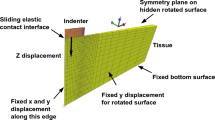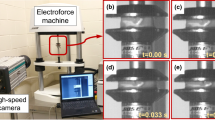Abstract
Brain biomechanics has been investigated for more than 30 years. In particular, finite element analyses and other powerful computational methods have long been used to provide quantitative results in the investigation of dynamic processes such as head trauma. Nevertheless, the potential of these methods to simulate and predict the outcome of quasi-static processes such as neurosurgical procedures and neuropathological processes has only recently been explored. Some inherent difficulties in modeling brain tissues, which have impeded progress, are discussed in this work. The behavior of viscoelastic and poroelastic constitutive models is compared in simple 1-D simulations using the ABAQUS finite element platform. In addition, the behaviors of quasi-static brain constitutive models that have recently been proposed are compared. We conclude that a compressible viscoelastic solid model may be the most appropriate for modeling neurosurgical procedures.
Similar content being viewed by others
Author information
Authors and Affiliations
Additional information
Received: 19 March 2002 / Accepted: 6 June 2002
Work is supported by a generous grant from the Whitaker Foundation. We would like to also thank Dr. Christos Davatzikos (Johns Hopkins School of Medicine, Baltimore, Maryland) for his help.
Rights and permissions
About this article
Cite this article
Kyriacou, S., Mohamed, A., Miller, K. et al. Brain mechanics For neurosurgery: modeling issues. Biomechan Model Mechanobiol 1, 151–164 (2002). https://doi.org/10.1007/s10237-002-0013-0
Issue Date:
DOI: https://doi.org/10.1007/s10237-002-0013-0




